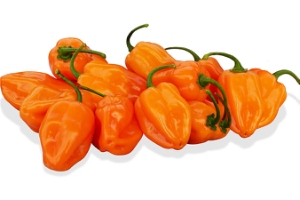
Rey Akul
| V37495 : Rey Akul | ||
|---|---|---|
| Treatment | * Pkg Size | ** Price (USD) |
| Treated | 100 seeds | $13.85 |
| Treated | 500 seeds | $61.15 |
| Treated | 1M seeds | $87.35 |
| Treated | 5M seeds | $404.25 |
| Treated | 25M seeds | $1,925.00 |
| Treated | 50M seeds | $3,700.00 |
|
* M = 1,000 ** US customer prices shown in USD. *** Canadian customers, please log in to see CA prices in USD. |
||
Attributes
Growing Tips
-
Hot Pepper Types
-
Anaheim
(Hatch - New Mexican) chili. Fruit are from 4 - 12” long and 2” wide, green to red at maturity, but also may be yellow, orange to brown. Many different varieties abound. Range from sweet to hot. Use green as fresh, canned or frozen. Mature are usually dried and ground into chili powder or paprika if sweet. Also used in salsas.Ancho
(Poblano) The fruit are heart shaped, pointed, thin walled with an indented stem attachment. Immature fruit are dark green with mature fruit being either red or brown. Fruit are 3 - 4” long and about 2” wide and are mildly pungent. The pepper of choice to make chili rellenos.Cayenne
Mature red fruit are 5 - 10” long and wrinkled. Irregular in shape, highly pungent, often used as dried, ground powder. Also used fresh in salads, sauces and dishes.Cherry
Like the name suggests, round or slightly flattened, green to red, hot or sweet. Similar use to wax pepper.Chinese
(Habanero-Scotch Bonnet- Bahamian-Jamacian) In this species, diversity is enormous. Popular in Jamaica, Yucatan and Brazil. Very, very hot and persistent, but aromatic. Fruit are 1 - 2½” long and 1 - 2” wide. Green to variable mature colors of yellow, orange, red or white. Use dried as a spice, fresh or processed. Plant starts slower than most other pepper types.Ghost
Subconical to conical shape measuring 2.5 to 3.5 inches in length. Approximately three times hotter than typical habaneros. Red is the most common color at maturity, with orange, yellow and chocolate as rarer varieties.Jalapeño
Fruit are thick walled, conical shaped, dark green when immature turning red at maturity and most cultivars are highly pungent. Fruit may show cracking or corkiness which is a desirable trait in Mexico. Length vary widely. Use canned, pickled, salsas or fresh. When dried, by smoking, they are called chipotle.Ornamentals
Peppers classified as ornamentals do not carry a characteristic that makes them in-edible. They are individuals from the many groups previously listed that happen to have leaves and fruit that are particularly attractive and give them ornamental value.Pasilla
Pod length is 6 - 12” long and 1 - 2” wide. Fruit color is dark green, turning brown at maturity. Usually dried before use in moles and salsas.Red Chili
Fruit are 2½” long by ½” wide, green when immature changing to red at maturity. Fruit have thin walls, taper to a point and are used for drying, processing and sauce. Hot!Serrano
Fruit are ½” wide and 2 - 3” long. Medium walls and shaped similar to Jalapeño and is the pepper of choice in Salsa Verde and other southwestern relishes.Thai Hot
Green fruit to red at maturity, very hot, tiny 3/8” wide by 1” long fruit. Popular in oriental markets.Wax
Yellow when immature, orange-red at maturity. Can be pungent or non-pungent. Vary from 2 - 8” long and about 2” wide. Use pickled or fresh in salads and relishes.
-
- Planting
-
Sow in the greenhouse 7 - 9 weeks before desired planting date. Allow plants to harden 7 days before transplanting. Plant transplants halfway between rootball and bottom leaves. This will help prevent lodging.
Planting Guidelines - PeppersApproximate Seeds per Pound:64,000 - 76,000Seeding Rate per Acre by Weight:2.2 - 2.6 ozSeeding Rate per Acre in M (1,000):9.1 - 12.1 MSeeding Rate Seeds per 1,000 foot of Row:500 - 667Seed or Plant Spacing In Row:18 - 24"Seed or Plant Spacing Between Rows:12"Seed or Plant Spacing Depth:.3 - .5"Recommended Soil Temperature:65 - 85°FDays to Germination:10 - 14
- Management
-
Scout every week to ensure crop development. Consult the Midwest Vegetable Production Guide or your local extension agent for identification and treatments.
- Harvest
-
Cut or break pepper off the plant but leave at least 1” of the stem attached to the pepper.
- Storage
-
Clean and wax peppers. Pre-cool at 45ºF. Store at 45 - 50ºF with 90 - 95% humidity; this will ensure the longest shelf life.

